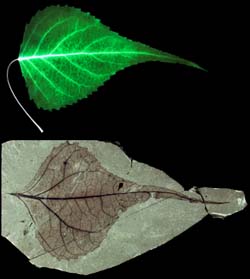|
WING AND
SLOAN found themselves at opposite ends of the debate, but they agreed
on one thing: if fossil gatherers and paleoclimate modelers ignored
each others' work, they would miss a great opportunity to understand
what the climate was like 55 million years ago, and how it got that
way.
And so, to the surprise of their colleagues, these
two scientists started talking to each other at scientific meetings,
keeping the lines of communication open even as they disagreed. Wing
ultimately decided to come to UC Santa Cruz as a visiting scientist
to work with Sloan. "We had this lively discussion about who was right,"
he says. "I thought it would be much more fun to talk about it in one
place."
Says Sloan, "My hope is that we'll publish a paper
together, after nine years of saying, 'She's wrong,' 'He's narrow-minded.'"
"It's the most productive argument I've ever been
involved in," says Wing.
Fossil gatherers and paleoclimate modelers use very
different tools and methods to study a time so distant that any conclusions
they reach are based on shaky assumptions.
Paleontology is the older science: more than 150
years of fossil research point to the warm winters Wing and other paleontologists
continue to study. Only since the advent of the supercomputer in 1976
have researchers used models to study the whys and hows of the Earth's
climate.
Paleontology proceeds in small incremental steps
as new fossils are unearthed, identified, and analyzed. Each new fossil
adds one data point to an already massive body of knowledge. Computer
modeling leaps ahead with startling new results, predicting how greenhouse
gases or changes in shoreline could have affected the ancient climate.
But these two disparate approaches feed off each
other. Modeling relies on data from the field, such as temperatures,
geography, and ages, to make its broad predictions. Fossil hunters and
geologists then look for new data to uphold or challenge the model's
predictions. The exchange continues as modelers incorporate the new
data into their theories. Neither method would explain as much about
our world without progress in the other.
<<
previous || next >>
|



|

